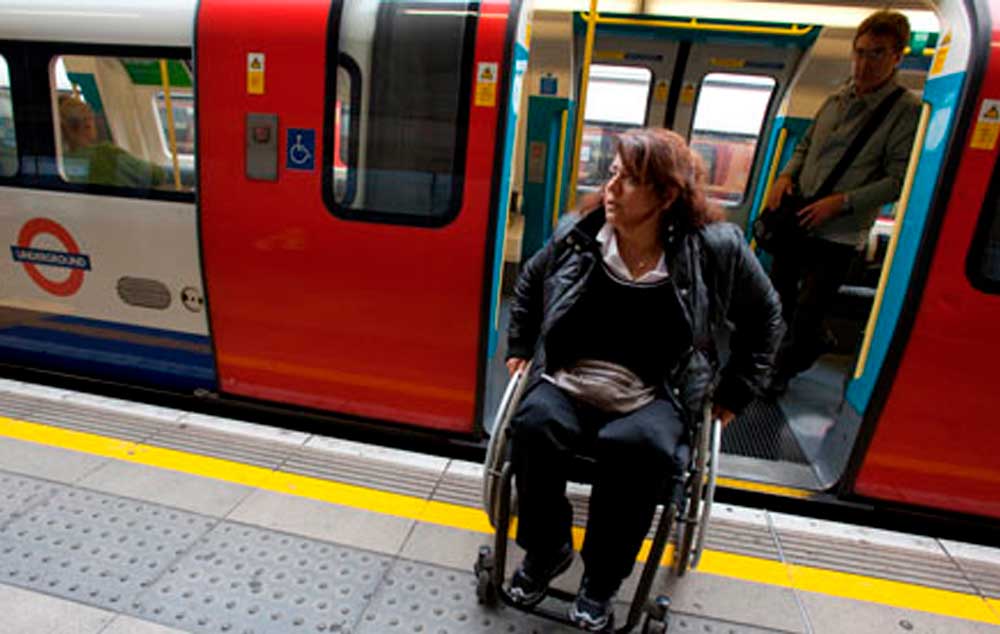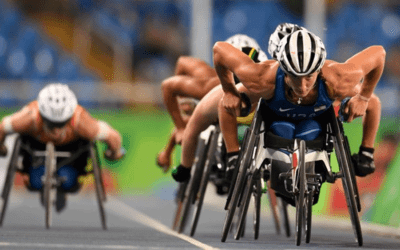
Disabled travellers lament lack of transport access for 2012 Olympic and Paralympic Games
Iman Saab has just been left behind by a London bus that she needed to take because her two nearest underground stations are inaccessible to her. After 20 minutes, another half-empty bus arrives but once again she is unable to board. The reason? The space she and her wheelchair would take is occupied by a pushchair and baby whose accompanying parent fails to move to let Saab in.
It’s a frustrating start to a journey Saab is taking with the Guardian to Stratford International, the nearest station to the Olympic stadium, to illustrate the experiences of people with disabilities on London’s transport network.
As the 2012 Olympics and Paralympics approach, and amid claims that they will be the most accessible ever, disability activists say the city is losing sight of that goal as austerity-driven cuts bite.
Rather than leaving a legacy that could transform the lives of tens of thousands of people with disabilities across the city, campaigners say that 2012 could be an embarrassment.
“Ironically, it seems as if the apartheid in the transport system is getting worse rather than better in the runup to the Paralympics,” said Jonathan Bartley, a Green party candidate for the London assembly who, as the father of a boy with spina bifida, tackled David Cameron on last year’s election trail over the alleged segregation of disabled children in the education system.
Nearly 80% of tube stations are still not accessible, including some serving Olympic venues, according to the campaign group Transport for All, while the everyday experience of wheelchair users attempting to navigate the city is one of being unable to board buses and being ignored by taxis, the group said.
Disability campaigners, who put Boris Johnson under pressure recently at the mayor’s Disability Capital Conference 2011, accuse Transport for London (TfL) of cutting targets on making bus stops accessible and stations step-free, and of cutting staff.
After reaching Waterloo station Saab takes a lift down to the Jubilee line platform and boards a train shortly before lunchtime. It’s not always so easy – try getting a wheelchair on to a tube during morning and evening rush hour. Also, while the carriages in this case are fairly level with the train – the Jubilee is the newest tube line – at other times there would be a need for a helping hand from a staff member, if one was around.
The journey improves further after changing on to the Docklands Light Railway, with its spacious trains, raised hand bar and flip-up seats.
Last month brought negative pre-Olympic publicity for transport authorities. They were accused of breaking the law, following the emergence of an internal TfL email instructing staff not to send “VIPs” – visually impaired people – to Victoria station during evening peak hours due to refurbishments for the next few weeks.
“There have been a few instances recently where VIPs have turned up at Victoria during this time and it has caused some problems,” it read.
It brought a rebuke from the Royal London Society for Blind People, which has its headquarters around the corner from the station and was taken entirely by surprise.
“London Underground has an ongoing legal duty to blind and partially sighted people under the Disability Discrimination Act,” said its director, Sue Sharp.
“Failure to honour their obligations as they carry out repairs and refurbishments would be both illegal and a serious dereliction of their duty.”
Bob Crow, general secretary of the RMT union, joined the criticism: “RMT warned when TfL bulldozed through their station staffing cuts as part of Boris Johnson’s £5bn cuts programme that the visually impaired and people with other disabilities would be hit hard and here we have the concrete proof.”
For visually impaired people such as Mohammed Mohsanali, one of the greatest obstacles may be other passengers, as he sets off from Victoria on a similar Stratford-bound journey to that taken by Saab.
At one point a tall man in a suit passes through the ticket stiles in front of Mohsanali, who touches his pass to open the barriers again. Turning around, the man charges back through the stiles, glancing at Mohsanali and his white cane before shouldering past. “You have to accept that you can’t control people,” says Mohsanali, who takes the jostling with a resigned smile, adding that he often asks members of the public for assistance.
As for TfL, he gives it seven marks out of 10, docking points for poor communication about problems such as diversions and closures.
Arriving into at the gleaming new station at Stratford, he says it was one he tends to avoid due to its layout, and notes the absence of audio announcements throughout his trip to and from Stratford International.
And Transport staff are also a mixed picture. While his experience of bus drivers in south London was excellent, he avoided taking buses in the east, where he said drivers were less helpful.
“Some just remain silent when you ask a question. Others don’t know where the bus terminates,” he adds.
Of most concern to him and Transport for All were the cuts, which they say mean less staff. Faryal Velmi, Transport for All’s director, said: “What is the point of TfL spending millions of pounds on improving access on the tube when the staff are not there to assist people? With the Olympics and Paralympics round the corner, we only dread to think what will happen when disabled visitors and even Paralympians attempt to use the tube.”
In the often embittered industrial relations on London’s transport network, the RMT union says that outlying stations are sometimes now left unstaffed, monitored instead from a one nearby. But TfL insists unmanned stations do not exist, adding that the Oyster card system means the number of customers using ticket offices has declined sharply.
Wayne Trevor, London Underground’s accessibility manager, said: “We are on track to help deliver a fantastic Olympic and Paralympic Games and are fully committed to making our network as accessible as possible both for 2012 and beyond.
“We have invested hundreds of millions of pounds in accessibility improvements over the last few years, meeting and exceeding the transport improvement commitments that we made.”
A total of 63 tube stations now have step-free access, with two more due to be ready by the time the Games arrive, and there is a network of 8,500 low-floor buses fitted with wheelchair ramps and onboard visual and audio announcements – the most accessible network in the country. Of the Victoria station situation, Trevor said all passengers had been asked to use an alternative station if possible after the start of refurbishments in January. Alternative transport to Victoria was organised for visually impaired passengers from nearby stations.
After arriving in Stratford on a journey that took 20 minutes longer than TfL’s online journey planner had predicted, Iman Saab is nevertheless impressed by what she finds. “This is a very good station in terms of access,” she says. “It would be great if this could be the future standard for other stations elsewhere.”
Source: The Guardian
Compartilhe
Use os ícones flutuantes na borda lateral esquerda desta página
Siga-nos!
Envolva-se em nosso conteúdo, seus comentários são bem-vindos!
Artigos relacionados
Acessibilidade no ESG. Equipotel aborda o tema para o turismo.
Acessibilidade no ESG, para o mercado do turismo. Equipotel aborda a importância da inclusão da pessoa com deficiência.
Morte Sobre Rodas. Filme inclusivo foi candidato ao Oscar.
Morte Sobre Rodas. Dois protagonistas do filme, são pessoas com deficiência, um usuário de cadeira de rodas e outro com paralisia cerebral.
Paralimpíada de Paris 2024. A deficiência não é um limite.
Paralimpíada de Paris 2024. A cidade luz sedia o maior evento esportivo do mundo para as pessoas com deficiência.






0 comentários